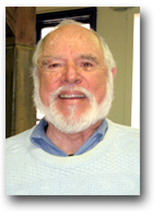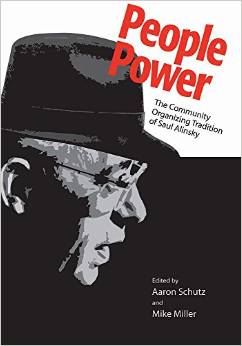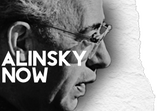Just Released!
People Power
The Community Organizing Tradition of Saul Alinsky
Edited by Aaron Schutz and Mike Miller
 Frank C. Pierson, Jr. Frank C. Pierson, Jr.
A Review By Frank C. Pierson, Jr.
The release of People Power, The Community Organizing Tradition of Saul Alinsky comes at an opportune political moment. In the months ahead Alinsky will be demonized (again) by the right as a way to attack Democratic nominee in waiting, Hillary Rodham Clinton, even as an avalanche of money drowns out credible voices of ordinary people whose needs and interests are systematically dissed. A so called Minsky moment triggered the Great Recession in December, 2007. A mountain of debt fueled by the economic bubble of prior years blew up as risk calculations proved fraudulent and the system crashed. Minsky’s theory was predictive of and helps explain the meltdown. We can only hope that an Alinsky moment will resuscitate American Democracy from a near death experience of its own. Maybe People Power, edited by Aaron Schutz and Mike Miller, will be a contributor in this regard. Strengths The editors do a good job on an opening chapter about Saul Alinsky and what they call his core concepts. It’s a useful primer. Thereafter they pursue the work of five of his colleagues - the most important in their eyes - as a vehicle for deepening an understanding of his impact. The book sparkles when some of the “shadow literature of organizing” is lifted from the dustbin of the overlooked and/or forgotten. Many of the pieces held up as representative retain energy, insight and currency that organizers, leaders and interested others are likely to appreciate and learn from. Several -- “Standing for the Whole” (Michael Gecan), “Making an Offer You Can’t Refuse” (Dick Harmon), “Organizing for Family and Congregation” (IAF), notes from an encounter with Tom Gaudette, an interview with Ernie Cortes, a Rev. Arthur Brazier retrospective on working with T.W.O., major speeches in hotly contested political environments including one by Baptist preacher and EBC leader Rev. Johnny Ray Younblood, Heather Booth’s critique of IAF (that triggered her creation of the Midwest Academy) --integrate successfully with the larger project of illuminating Alinsky’s legacy and relevance for today. The “shadow literature” of broad based organizing is vast and much of it remains buried in the files and hard drives of leaders and organizers with rich experience and important perspectives deserving of public consideration. People Power begins the serious excavation. Critiques Schutz and Miller overstate the role of Nicholas von Hoffman and lend credence to his mis- characterization -- as formulaic and unimaginative --of the organizers who took over the IAF after Alinsky died. Sanford D. Horwitt first opened the door in this direction in Let Them Call Me Rebel by inflating von Hoffman’s role in the IAF story. Subsequently descriptors like “grind” used by von Hoffman himself in Radical, A Portrait of Saul Alinsky further diminish the men who made the post Alinsky, Modern IAF happen. In People Power von Hoffman, in the same vein, tags Alinsky’s successors as unimaginative (think a Ford like assembly line), presumably referring to Ed Chambers (who among other remarkable accomplishments had the imagination to save T.W.O from the shambles it was in when Nick von Hoffman left) and Dick Harmon (whose creativity was always apparent in his productive work and recognizably so in these pages). |
This particular spin matters because it obscures the very organizational developments and their authorship that may offer the most promising paths forward. The editors would have been wise to better scope all this out. To tag IAF organizing post Alinsky as “inflexible” and “unimaginative” is to run headlong into real world evidence to the contrary. COPS, UNO, EBC, BUILD, Valley Interfaith, TX IAF, international expansion, the sprawling IAF regionals - Metro and West/Southwest - reinvented whatever model Alinsky conceived and sharply ramped up citizen organizing on a power political curve.
It follows that People Power suffers from insufficient attention to four key figures in the post Alinsky organizing world - Ernie Cortes, Mike Gecan, Sr. Christine Stephens and Arnie Graf. To be sure many of the most productive years of all four happened after the period of the book’s primary focus, but their work decisively debunks the “unimaginative” rap noted above and breaks open new organizational vistas. The omission of Sr. Christine Stephens whose pivotal role in shaping IAF is especially glaring. Readers are denied an opportunity to explore more fully and hopefully what Alinsky and IAF turned loose on the public, political world. Readers would also benefit from a more probing look at the differences between organizations within similar looking organizational types. This, along with mining the experience of the two exemplars in the book that are out of business or on life support (Shel Trapp’s block club organizing and ACORN), would have helped lay a more solid foundation for future thinking. All organizations/networks are not created equal. Not in depth, scope, impact, endurance or prospects. On the subject of strategic vision, People Power is thin. Reinvent block clubs with interns connected to a university? Pull together leaders and organizers to develop a national platform? The former seems insufficient and improbable while the latter falls more into the “what else is new” category. Stacked up against what IAF and, I suspect, other networks are already doing by way of future think, both suggestions seem uninspired. Still, I credit the editors for giving the matter a shot and, more important, contextualizing why strategic vision is a major, current challenge confronting anyone - individual or organization - interested in social change. Conclusion In concluding commentary, Schutz and Miller remind readers of the preponderance of evidence that democracy as a whole in the USA is on life support - the “plutocrats”, as they tag them - are winning, The editors are clear that thinking in generational terms informed by the successes and failures of the past is a requirement. Their book helps stir the pot in this regard. Right now that’s a big part of what’s needed and why People Power is a timely read. |





